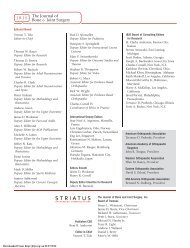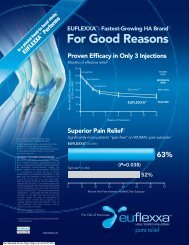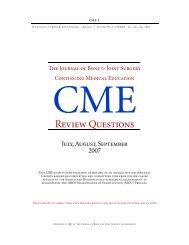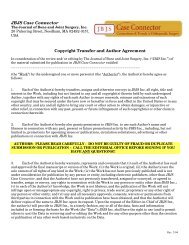Lower-Extremity Rotational Problems in Children - The Journal of ...
Lower-Extremity Rotational Problems in Children - The Journal of ...
Lower-Extremity Rotational Problems in Children - The Journal of ...
Create successful ePaper yourself
Turn your PDF publications into a flip-book with our unique Google optimized e-Paper software.
Femur<br />
Our study showed that <strong>in</strong> early <strong>in</strong>fancy lateral rotation<br />
<strong>of</strong> the femur is greater than medial rotation, but that with<br />
advanc<strong>in</strong>g age lateral rotation decreases while medial ro<br />
tation <strong>in</strong>creases (Figs. 2-B. 2-C, and 2-D). <strong>The</strong> f<strong>in</strong>d<strong>in</strong>gs <strong>in</strong><br />
this study were consistent with previous f<strong>in</strong>d<strong>in</strong>gs for mean<br />
values dur<strong>in</strong>g childhood4°@53.15.25but <strong>in</strong> addition provided<br />
a range <strong>of</strong> normal values. This normal range is great at all<br />
ages. with the upper limit <strong>of</strong> medial rotation be<strong>in</strong>g about<br />
65 degrees <strong>in</strong> male subjects and 60 degrees <strong>in</strong> female sub<br />
jects (Figs. 2-B and 2-C). <strong>The</strong> lower limit <strong>of</strong> lateral rotation<br />
is about 25 degrees for both sexes.<br />
Severity <strong>of</strong> medial femoral torsion may be graded as<br />
follows: mild if medial rotation is between 70 and 80 degrees<br />
and lateral rotation is between 10 and 20 degrees (two or<br />
three standard deviations from the mean). moderate if me<br />
dial rotation is between 80 and 90 degrees and lateral ro<br />
tation is between zero and 10 degrees (three or four standard<br />
deviations), and severe if medial rotation is greater than 90<br />
degrees and no lateral rotation is possible (more than four<br />
standard deviations). <strong>The</strong> degree <strong>of</strong> jo<strong>in</strong>t laxity <strong>in</strong>fluences<br />
these values, and both medial rotation and lateral rotation<br />
will be <strong>in</strong>creased <strong>in</strong> a child with jo<strong>in</strong>t laxity.<br />
<strong>The</strong> relationship between rotation <strong>of</strong> the hip and ra<br />
diographically measured femoral anteversion was studied<br />
by Staheli et al.32. A reasonable correlation was found,<br />
although other factors, such as acetabular <strong>in</strong>cl<strong>in</strong>ation. can<br />
affect rotation <strong>of</strong> the hip.<br />
Tibia<br />
Tibial rotation is def<strong>in</strong>ed as the relationship beween<br />
the axis <strong>of</strong> rotation <strong>of</strong> the knee and the transmalleolar axis2'.<br />
In 1909. le Damany measured the rotation <strong>in</strong> 100 dried<br />
tibiae'1. In the newborn. the average angle <strong>of</strong> the trans<br />
malleolar axis was 4 degrees <strong>of</strong> medial rotation. <strong>The</strong>reafter.<br />
lateral rotation gradually <strong>in</strong>creased throughout childhood<br />
40e<br />
200<br />
0<br />
-20°<br />
-40°<br />
VOL. 67-A, NO. I. JANUARY 1985<br />
LOWER-EXTREMITY ROTATIONAl. PROBLEMS IN (I-IILDREN 45<br />
Ft;. 3<br />
until the mean rotation was 23 degrees <strong>of</strong> lateral rotation.<br />
with a range <strong>of</strong> zero to 40 degrees <strong>in</strong> @idults.<br />
Later studies confirmed this early work. Nachlas oh<br />
served that medial rotation <strong>of</strong> the tibia is common <strong>in</strong> the<br />
orangutan and gorilla. and suggested that medial tihial tor<br />
sion is an atavistic variation4. Hutter and Scott measured<br />
forty adult skeletons and found that the mean lateral tihial<br />
rotation was 21 degrees on the right and 19 degrees Ofl the<br />
leftâ€. <strong>The</strong>y then studied fifty children, two to three years<br />
old, and found that 30 per cent had <strong>in</strong>-toe<strong>in</strong>g. usually due<br />
to medial tibial torsion. <strong>The</strong> prevalence was 8 to 10 per cent<br />
<strong>in</strong> the five to seven-year age group and 8 to 9 per cent <strong>in</strong><br />
early adolescence, with a nearly equal sex distribution. <strong>The</strong>y<br />
also found that 3 per cent <strong>of</strong> 200 adults whom they studied<br />
showed persistence <strong>of</strong> significant medial torsion. hut this<br />
was not def<strong>in</strong>ed. <strong>The</strong>y considered this to be a serious prob<br />
lem <strong>in</strong> about 1 per cent.<br />
Wynne-Davies. us<strong>in</strong>g a special caliper to measure tihial<br />
rotation <strong>in</strong> normal adults5@' found that it ranged froni zero<br />
to 40 degrees <strong>of</strong> lateral rotation. the mean be<strong>in</strong>g 20 degrees.<br />
Khermosh et al. studied tibial rotation <strong>in</strong> 230 children <strong>in</strong><br />
<strong>in</strong>fancy and early childhood and found that the mean lateral<br />
rotation was 2 degrees at birth and 10 degrees at the age <strong>of</strong><br />
five years'4. Staheli and Engel used a caliper method to<br />
survey 160 normal children5. <strong>The</strong>y found a gradual <strong>in</strong>crease<br />
from 5 to 14 degrees <strong>of</strong> lateral rotation between the ages <strong>of</strong><br />
one and thirteen years. while Ritter et al. found the <strong>in</strong>crease<br />
to be from 4 degrees at birth to I 1 degrees at two years@.<br />
Malekafzali and Wood, <strong>in</strong> 200 adult subjects. found the<br />
normal range to be from 7 to 20 degrees <strong>of</strong> lateral rotation.<br />
with a mean <strong>of</strong> 14 degrees21.<br />
<strong>The</strong> current study demonstrated that the angle <strong>of</strong> the<br />
transmalleolar axis and the thigh-foot angle become pro<br />
gressively larger lateral angles throughout growth (Figs.<br />
2-E and 2-F). <strong>The</strong> f<strong>in</strong>d<strong>in</strong>gs relative to the angle <strong>of</strong> the trans<br />
malleolar axis were comparable with those found <strong>in</strong> other<br />
studies. From the middle <strong>of</strong> childhood through adult life.<br />
. . .<br />
1 3 5 7 9 11 13 15-19 30's 50's<br />
Age (years)<br />
Comiiparison <strong>of</strong> the angle <strong>of</strong> the transmalleolar axis ITMA) amidthe thigh-fiat angle (TFA).<br />
70+<br />
IMA<br />
TFA
















